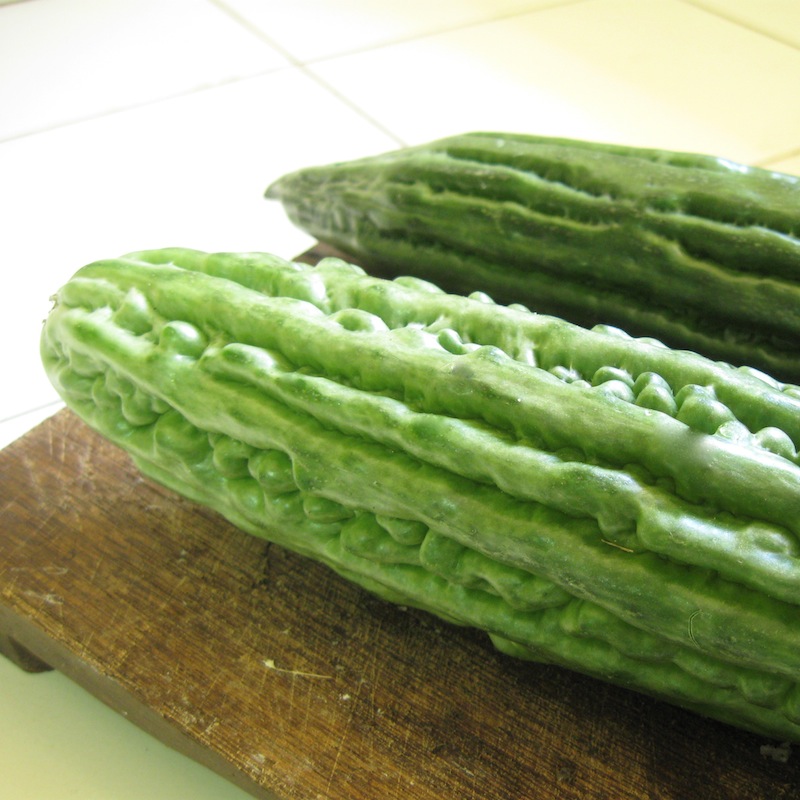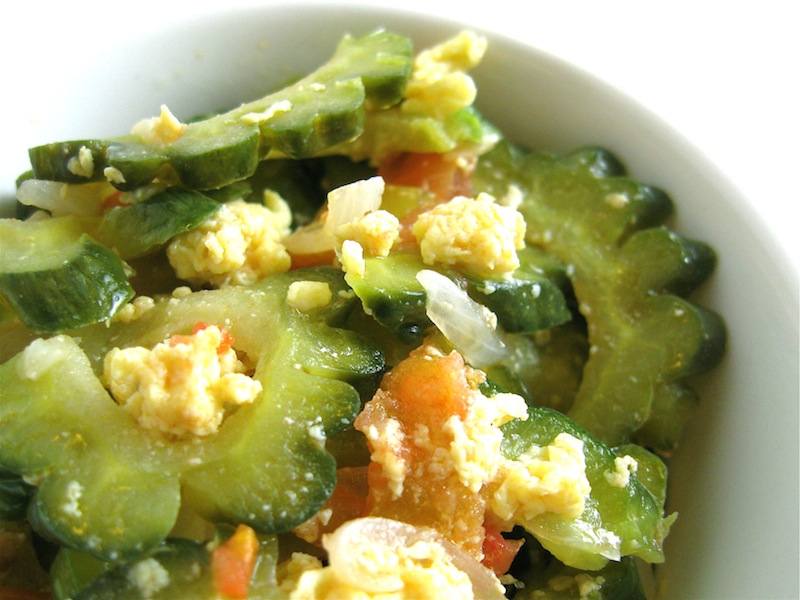“Why so blue, Red?” Spinach asked ironically.
“They called me a vegetable wannabe,” replied a less-than-cheery Cherry Tomato, pointing to a group of gourds nearby.
“Ignore them,” Rhubarb tartly advised. “They’re just Bitter Melons.”
You’ve probably come across them at the farmers’ market - strange produce that look like cucumbers with a bad case of warts. Perhaps you stopped to examine them, wondering how they would taste. Maybe you even asked the friendly vendor what they were, only to turn away at the word ‘bitter’, leaving behind those lonely knobby gourds for another curious shopper to find.
 The unusual vegetable is known by various names, such as balsam pear, bittergurke, caraille, and goya, but none is more appropriate than bitter melon. Acrid and sharp on the tongue, Momordica charantia is the misfit in a plant family that counts watermelons and cantaloupes among its members. Unlike its sweeter cousins, however, it contains momordicines, some of the most bitter compounds found in food, which give it that characteristically astringent flavor. Of the five tastes, which include sweet, sour, salty, and savory (umami), bitter is the least appealing to many palates, and for good reason: it is Mother Nature’s warning signal to beware eating potentially poisonous plants. But thanks to intrepid early diners who managed to get past the harsh taste and confirm that it is indeed edible, we now know that bitter melon may be more elixir than poison.
The unusual vegetable is known by various names, such as balsam pear, bittergurke, caraille, and goya, but none is more appropriate than bitter melon. Acrid and sharp on the tongue, Momordica charantia is the misfit in a plant family that counts watermelons and cantaloupes among its members. Unlike its sweeter cousins, however, it contains momordicines, some of the most bitter compounds found in food, which give it that characteristically astringent flavor. Of the five tastes, which include sweet, sour, salty, and savory (umami), bitter is the least appealing to many palates, and for good reason: it is Mother Nature’s warning signal to beware eating potentially poisonous plants. But thanks to intrepid early diners who managed to get past the harsh taste and confirm that it is indeed edible, we now know that bitter melon may be more elixir than poison.
This acerbic gourd is a common and very popular food throughout the world, particularly in Asia, where it is valued for its medicinal qualities as well as its bracing flavor. Karela, as it is known in India, is used in the ancient holistic healing science of Ayurveda to balance the body’s doshas, or constitution, and to treat a variety of ailments ranging from digestive upset to skin irritations to bacterial and viral infections. In the Philippines, bitter melon is called ampalaya and is touted as a diabetes treatment; a 2007 study by the Philippine Department of Health found that eating its leaves results in a hypoglycemic effect, or lowering of blood sugar, while results from a joint Australian/Chinese research showed that its compounds help improve glucose uptake. Currently, bitter melon extract is being studied for potential anti-cancer properties. However, the same compounds that relieve illness in some people may cause complications in others – they can exacerbate hypoglycemia in diabetics already taking blood sugar-lowering medications, while pregnant women are strongly advised not to consume bitter melon as it may cause bleeding and premature contractions.
Still, bitter melon is full of vitamins and minerals, including vitamins A and C, iron, calcium, and beta carotene, to rival the amounts found in such healthful vegetables as broccoli and spinach . . . if you can get past the mouth-puckering taste. To untrained taste buds, bitter melon is nearly inedible in its raw state, but its pungent flavor can be softened with some simple tips on choosing and preparing the gourds.
 Choosing Bitter Melon
Choosing Bitter Melon
- You may see two kinds of bitter melon at the market: the ‘Chinese’ variety is long with a light green, pebbled texture, while the ‘Indian’ type is shorter, darker green and covered with spiky knobs. Any difference in bitterness between these types may be negligible to anyone not used to its flavor, so feel free to use either. However, the Chinese variety may be more common in American markets.
- Bitter melon is a subtropical vegetable that grows best in hot, humid weather, so watch out for it at the farmers’ market in July and August.
- Choose specimens that are firm and light green - the darker the color, the younger and more bitter it is.
Preparing Bitter Melon
- Bitter melon does not have to be peeled. Just rinse well to remove any dirt and pat dry.
- Cut in half lengthwise, then use a spoon to scoop out the seeds and scrape off the inner white pith.
- Slice crosswise at a slight angle to ¼-inch thickness, then place in a bowl. Cover with fresh water and add 2-3 tablespoons of salt (rock salt, preferably). Let sit for about 15 to 20 minutes and drain just before cooking.
Bitter Melon with Egg and Tomatoes
When I polled friends and family in Manila about how best to extract the bitterness from ampalaya, I received a different answer each time. From squeezing the slices after soaking, to not stirring while cooking, each method was declared the best. Honestly, there is no way to extract the astringent flavor entirely, but don’t let that deter you. Though it may be an acquired taste, you just might find its assertiveness to be a pleasant change from more mild-mannered vegetables. This recipe is a favored preparation in the Philippines and is a quick, simple showcase for bitter melon at its tastiest.
 Ingredients
Ingredients
2 bitter melons, prepared as above
1 small onion, sliced thinly
3-4 cloves of garlic, minced
2 plum or Roma tomatoes, chopped
1 egg, lightly beaten
Water
Salt (preferably rock salt)
Cooking oil
- Drain the bitter melon slices, place in a wok or large sauté pan and add fresh water to cover. Over medium high heat, bring to a gentle boil and cook for about 1-2 minutes. Drain slices in a colander and set aside.
- Return wok or pan to the burner and heat a generous tablespoon of cooking oil. Add onion and garlic, and stir-fry until they just begin to brown. Add chopped tomatoes and continue stir-frying until they begin to break down. Pour one cup of water and add a tablespoon of salt to the pan, then bring to a low simmer.
- Add bitter melon slices and stir well until liquid comes back to a gentle simmer. Pour beaten egg over the vegetables and quickly mix in so that the egg cooks in fluffy bits throughout. Cook until the bitter melon slices are tender but still a bit firm to the bite. Serve with steamed rice.

Tracey Paska lives, eats and writes in Manila, Philippines, where she revels in the fact that she can wear flip-flops outdoors in January. When she's not exploring Manila's foodscape, she freelances for a national food magazine and writes about the complex and fascinating connections between food, culture, and society on her blog Tangled Noodle.




